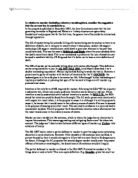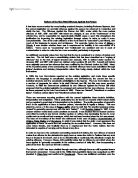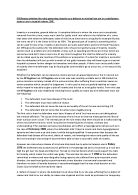Torture And Terrorism
The terrorist attacks of 9/11 has brushed in a new era of interrogation techniques that may or may not be protected by national and international laws, depending on how one defines detainees and torture. These techniques are considered torture and are used to get valuable information from detainees. These techniques violate various laws; it takes place in certain places, there are reasons why it goes on there and the definition of torture can be misconstrued. The treatment of prisoners including, but not limited to torture or lite torture could be interpreted as being protected under a few amendments to the constitution. The eighth amendment has a clause against cruel and unusual punishment. Also, the due process clause of the 5th and14th amendment could also protect against being deprive of life, liberty, and property without due process of law. Not only those but in a few landmark cases such as Brown v. Mississippi in which the defendant thought he was being hung and was also beaten brutally until he finally confessed when he was about to be hung. In the Rochin v. United States developed the "shock the conscience" in this landmark case. In this case the defendant was approach by police and he swallowed what appeared to be drugs and the officers had his stomach pumped, which violated his constitutional rights. Though we as Americans expect all of these rights, we
In relation to murder (including voluntary manslaughter), consider the suggestion that the current law is unsatisfactory.
In relation to murder (including voluntary manslaughter), consider the suggestion that the current law is unsatisfactory. In the proposals published in December 2005, the Law Commission says that the law governing homicide in England and Wales is a 'rickety structure set upon shaky foundations' and propose that for the first time, the general law of homicide be rationalized through legislation. The AR of murder being the unlawful killing of a human being can be unclear as there is no definition of death, nor a ruling as to exactly when it takes place, modern life support technology (life support machine) can make death a gray area whereas in the past they would have died. This was the case in Malchrek and Steele where the court decided obiter that death meant brain dead. This is not considered a problem as the rule of causation can be used to establish liability. CLR agreed that it's better not to have a strict definition of death. The MR of murder us the unlawful killing done with malice afterthought. This definition can be complicated for a jury. In AG REF NO.3 1994- Lord Mustill described it as 'a doubly misleading expression'. Malice implies bad feeling towards the victim. However a person can be guilty of murder with the best of intentions for the V. COCKER- the husband gave in to his wife plea to terminate her life. 'Afterthought' is also misleading as it implies
Problems with the Law on Theft
Problems with the law on Theft The offence of theft is described in s1 Theft Act 1968 which states that, "A person is guilty of theft if he dishonestly appropriates property belonging to another with the intention of permanently depriving the other of it". As can be seen by the date of the statute, 1968, it has been in force for a long time, but there have been many criticisms levelled at the current law on theft. Firstly, the range of elements that make up the actus reus have developed some flaws over time. The actus reus of theft requires that the defendant appropriates property belonging to another. The issue of appropriation has raised a major issue over recent years. This being the apparent consent to any appropriation. The first case where this problem featured was in the case of Lawrence. In this case, Lawrence, a cab driver helped himself to an extortionate charge, after the Italian student who got in his cab presented him with his wallet. The Italian student was not familiar with English currency, which is why he asked Lawrence to help himself to the correct fare. Despite Lawrence arguing the student giving him consent to taking the money it was still held to be an appropriation. Later, Gomez urged his employer to accept stolen cheques as payment for electrical goods. Even though the manager had to consented to the transaction, it was still held to be an
Jury and Magistrate Exam Questions
SECTION B: THE LEGAL SYSTEM [8.a] Explain the work of lay magistrates in criminal courts. (10 marks) Magistrates are also known as 'Justices of the Peace' and are responsible for ensuring the law is upheld. The term 'Justices of the Peace' was first used in 1361 and the role has development since then. Lay magistrates are unpaid, except for expenses, and unqualified. They sit as a bench of three in magistrate's court, hearing 96% of all criminal trials. Magistrates are suppose to reflect society meaning that there should be a race, gender, and age balance in the local area in which they sit. Once a magistrate has been appointed they are required to sit for at least 26 half-days each year. They normally work as part of a bench of three magistrates. There is a chairman and two wingmen, which are often less experienced than the chairman. There are five specific roles which are carried out. The judicial decisions that are made by magistrates are only whether the defendant is guilty or innocent. This decision is made due to a trial about either a summary offence or an either way offence. The magistrates also decide on the sentence which for one offence is a maximum of six months or a maximum fine of £5,000. As magistrates are not legally trained, there is always available advice from the Justices clerk who can explain the relevant points of law and give advice on possible
Human Trafficking In Australia. This essay will be covering different aspect of human trafficking and slavery in ways of legal and non-legal response. It will also be responding on how effective the legal system is in regards of human trafficking on the
Human Trafficking Human trafficking can be considered to be many things. It can be separated into different types of trafficking such as sex trafficking, labour trafficking, child soldiers and organ trafficking. Sex trafficking and labour trafficking are to be of the most popular types of trafficking. Trafficking is very common worldwide. It is an everyday occurrence in every single country of the world, although it goes to higher and more drastic extents in some countries. The number of people trafficked into Australia is low compared to many other countries with most victims in Australia being women working in the sex industry. This essay will be covering different aspect of human trafficking and slavery in ways of legal and non-legal response. It will also be responding on how effective the legal system is in regards of human trafficking on the slave trade. Slavery is a system of which people are treated as property, and are used for labour. Traditionally, most people think that slavery is where people are chained up and controlled, where people are bought and traded like property. Slavery used to be considered as a legitimate industry up until the 19th century. Slavery and Human Trafficking used to be considered as a legitimate industry for labour, there were even laws that were formed to regulate the trade. The first of the movement to abolish the slave trade was
role of judges in civil cases
Describe the roles of judges in civil cases, both in trial courts and appeal courts. The work that a judge does depends on the level of court that he works in. Before trying a civil case the judge reads the relevant case papers and becomes familiar with their details. The vast majority of civil cases tried in court do not have a jury - libel and slander trials are the main exception - and the judge hears them on his own, deciding them by finding the facts and then applying the relevant law to them - there may be considerable argument about what that law actually is, the judge has to interpret it, often to find parliaments intent when passing the act. Judges also play an active role in managing civil cases once they have started, helping to ensure they proceed as quickly and efficiently as possible. The judge ensures that all parties involved are given the opportunity to have their case presented and considered as fully and fairly as possible. During the case the judge will ask questions on any point he feels requires clarification, or which he feels is relevant and will help with his decision but has not been covered. The judge also decides on all matters of procedure which may arise during a hearing. Once the judge has heard the evidence from all parties involved and any submissions they wish to put forward, he delivers his judgment. This may be immediately, or if the case
Briefly explain the meaning of, and reasons for, strict liability as a criminal offence
Briefly explain the meaning of, and reasons for, strict liability as a criminal offence (8 marks) Strict liability are offences which require no mens rea. A person can be guilty of the offence by just having the actus reus. This can seem unfair as one may not have the intention to commit the offence but just by having the conduct and consequence is sufficient. For example, in relation to speeding, it is sufficient if one can prove that they are above the speed limit, the intention of speeding is not required. As seen in the case of Larsonneur, the defendant didn't have the intention to return back to the UK, hence there was no mens rea; however, the act of being present in the UK was sufficient for a strict liability offence. Some examples of strict liability offences can include parking and speeding offences, selling unfit food for human consumption, health and safety at work regulations, trade description offences etc. Even though these offences may seem small, they are common as nearly 50% of strict liability cases are taken to court. The type of court would depend on the fine limit; i.e. the Magistrates court would fine up to £5000, however, the Crown court do not have a maximum penalty, but in severe cases, it could lead to imprisonment. The case of Gommon (Hong Kong) LTD V Attorney General for Hong Kong was a House of Lords case. Lord Garmon sets out the
Explain the meaning of the term "causation"
Explain the meaning of the term “causation” Sometimes the defendant’s actions have to result in a particular consequence. These are known as result crimes; an example would be assault occasioning actual bodily harm, where the conduct is assault and the result ABH. The rules of causation decide whether the defendants act caused the prohibited consequence. The court must establish both causation in fact, and causation in law. To determine factual causation, the “but for” test is used. This says that but for the defendants conduct, would the victim have suffered the harm. An example of the but for test would be in R v White, where the defendant put cyanide into his mothers drink, however she died of heart failure before the cyanide could affect her. The but for test showed she would have died regardless of him putting cyanide into her drink, so there was no factual causation. Once factual causation has been established, the court must then establish legal causation. This asks whether the defendant made a significant contribution to the injury. In R v Blaue a Jehovah ’s Witness was stabbed and refused a blood transfusion, that would have saved her life. She later died, and the defendant was found guilty as he made a significant contribution to her death. If a victim acts in a foreseeable way such as in R v Roberts, where a woman was being sexually abused and
OCR Feb 10 Exam Paper Non-Fatal Offences Problem Case. The scenario states that Colin ran towards Sarah waving a knife. The actions by Colin caused Sarah to scream.
OCR Feb 10 Exam Paper - Non-Fatal Offences Sarah is walking home when Colin runs towards her waving a knife. Sarah Screams. Colin grabs Sarah's coat and then punches her in the face which breaks her nose and causes her to fall to the ground. Gregory, a passer-by, runs to help Sarah. Colin lunges wildly at Gregory with the knife and slashes Gregory's hand, causing severe bleeding. Colin takes aim and kicks Sarah in the stomach, causing serious internal injuries. [35] The scenario states that Colin ran towards Sarah "waving a knife". The actions by Colin caused Sarah to scream. The Actus Reus for assault is 'any act which causes the 'victim' (V) to fear immediate unlawful force'. The meaning of immediate was defined in the Smith (1983), a case where a man looked into the window of a women in her flat thus causing her to be terrified, as to meaning "imminent". The fact that Sarah screamed after seeing Colin running towards her illustrates she feared of action imminently. The Mens Rea for Assault is 'intention or recklessness to cause another to fear immediate unlawful force'. By referring to the definition set out in Smith, Richard waving the knife around, coupled with him heading towards Sarah, clearly shows that he was reckless as to make Sarah fear imminent unlawful force. Colin is therefore guilty of committing the Common Law offence of assault, and can be sentenced up to
Explain the meaning of Actus reus and mens rea
CRIMINAL LAW Explain the meaning of actus reus Actus reus is the Latin term for a guilty act or the prohibited conduct. It must be a voluntary act as stated in Bratty v by Denning. An involuntary act is one done by the muscles without control of the mind or you may be concussed. Actus reus is all the external elements of a crime. Actus reus can also be an omission. The general rule is that there is no duty to act as stated by Stephens J when he said that there was no obligation to save a stranger from drowning, however there are exemptions. For example having a duty to act because of your contract as illustrated in R v Adomako where the anaesthetist failed to notice a detached oxygen tube and thus failed to carry out his contractual obligations; in R v Gibbons & Proctor it was held that there is a duty to look after your relatives (need not be blood related) where a father and step mother failed to care for their daughter/step daughter; in R v Stone and Dobinson it was held that where you take on responsibility for care then you have a duty to fulfil that care unlike in this case where Stone was held to have failed in his duty to look after his sick sister adequately after she moved into his home. In R v Miller it was held that failing to resolve a dangerous situation you created could lead to liability – the defendant accidentally set light to a mattress and then moved

























